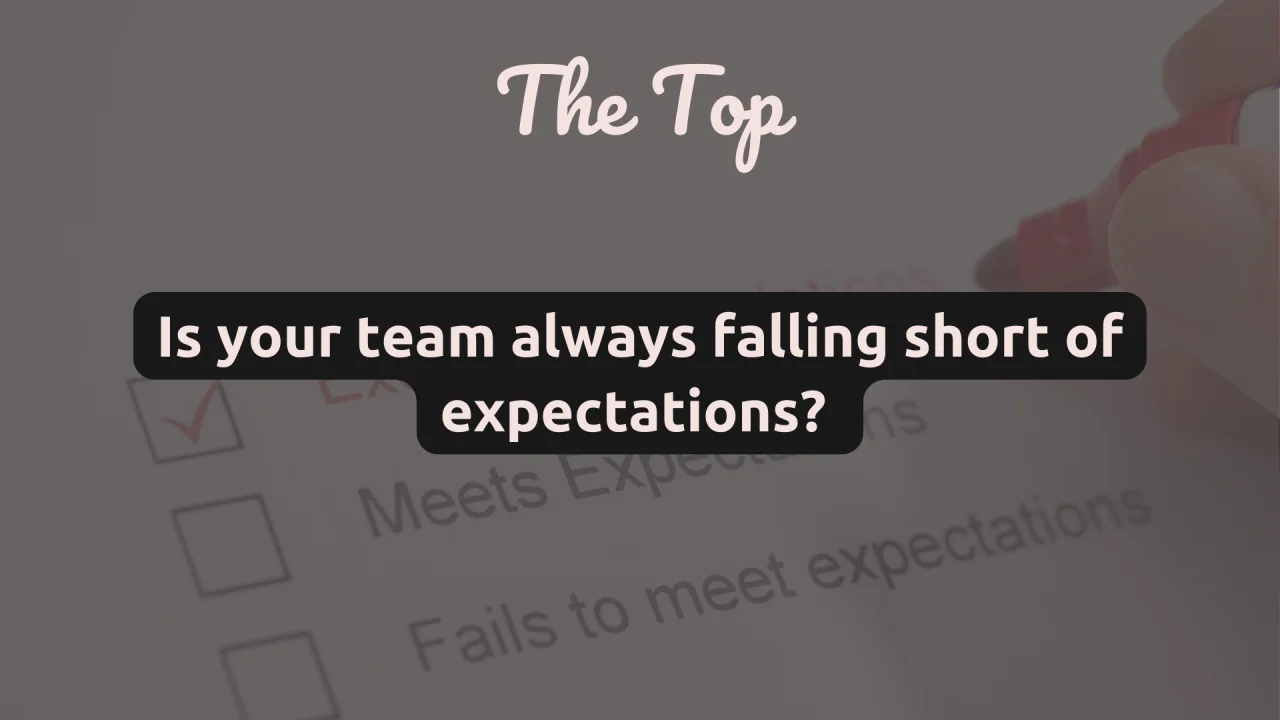5 Great Expectation Setting Tricks Every Manager Needs
As a leader, setting expectations at work is crucial to ensure that your team is aligned toward achieving common goals. But with different personalities and skill sets in the mix, setting expectations that everyone understands and meets can be challenging. In this blog post, we’ll dive into why setting expectations is essential in the workplace, the role of leaders in expectation setting, and share five tips for effective expectation setting at work. We’ll cover everything from clear communication and specificity to using the SMART framework and connecting expectations to metrics and feedback. We’ll also discuss common mistakes to avoid in expectation setting and how to handle unmet expectations. So whether you’re a new manager or an experienced leader looking to improve your leadership skills, keep reading for some valuable insights on expectation setting at work.- 5 Great Expectation Setting Tricks Every Manager Needs
- Why is setting expectations important in the workplace?
- The role of leaders in expectation setting
- 5 tips for effective expectation setting at work
- How to effectively communicate workplace expectations?
- What are the common mistakes to avoid in expectation setting?
- How to handle unmet expectations at work?
- Conclusion
- FAQs
- Other Related Blogs
Why is setting expectations important in the workplace?
Setting clear expectations in the workplace is crucial because it can improve employee performance and productivity. It helps prevent misunderstandings and conflicts among team members while providing employees with a sense of direction in their work. Setting expectations also promotes accountability and ownership of tasks and responsibilities, which can lead to a more productive and efficient workforce.Guide the team in a single direction
As a leader, your job is to guide your team in a single direction, and setting clear expectations is the first step toward achieving that. By communicating specific goals and objectives, a manager can ensure that everyone understands what they need to accomplish and how they will be measured. It creates a shared understanding of what success looks like, which can help align everyone’s efforts toward achieving common goals. This prevents confusion or miscommunication that can derail projects or cause unnecessary delays.Create accountable teams
Setting expectations also helps create accountable teams. When everyone knows what is expected of them, they can take ownership of their tasks and responsibilities. It can lead to greater pride in their work and a desire to meet or exceed expectations. Additionally, setting clear expectations can help identify any skills or knowledge gaps that need to be addressed, which can help employees grow both professionally and personally.Prevents confusion and chaos
Clear expectations also prevent confusion and chaos in the workplace. When employees know exactly what they are responsible for and how to achieve their goals, there is less room for misunderstandings or mistakes. As a result, it creates a more efficient and productive workplace, as everyone knows what they need to do and how to do it. It can also help reduce stress and frustration among team members, as they clearly understand what is expected of them. Ultimately, setting clear expectations is critical to effective leadership, as it helps create a positive work environment that promotes teamwork and success. Regularly revisiting and adjusting expectations can help facilitate continuous improvement and growth for both the individual and the team as a whole. Therefore, leaders should take time to communicate clearly with their team members about their expectations so that everyone has a common understanding of what is expected of them. It will ensure everyone is working towards the same goals, making the entire team much more effective.The role of leaders in expectation setting
Leaders play a critical role in expectation setting within the workplace. Leaders must communicate expectations clearly to team members, including goals and individual responsibilities. Regular feedback and performance evaluations are necessary to ensure that team members know where they stand and how to improve. In addition, establishing a culture of transparency and open communication fosters trust and accountability among team members. Encouraging team members to set their expectations and goals aligned with the organization’s overall objectives can also help them stay motivated and engaged. Leaders must continuously evaluate and adjust expectations as required, considering business priorities or team dynamics changes.Other Interesting Reads
5 tips for effective expectation setting at work
Effective expectation setting is crucial for leaders to ensure their teams work towards a common goal. Here are five tips to keep in mind when setting expectations at work:Start with clear communication
Effective expectation setting at work requires clear communication from the manager. As a leader, it’s important to be specific and provide details about what you expect from your team. It includes making sure everyone understands their roles and responsibilities. It’s also crucial to set realistic goals and deadlines that are both achievable and challenging. But, again, setting these in consultation with the team is the best way forward. Regularly checking in with your team is another key aspect of practical expectation setting. It allows you to ensure that everyone is on track and progressing toward your goals. Additionally, if adjustments need to be made, regular check-ins allow you to make those changes before it’s too late. By starting with clear communication, you can create a foundation for successful expectation setting at work. You can check out fun activities to make this process easier: 5 Creative Expectation Setting Activity For All ManagersBe specific and realistic in setting expectations
One of the key tips for effective expectation setting at work is to be specific and realistic. Being specific helps to avoid confusion and misunderstandings by clearly outlining the desired outcome and the steps needed to achieve it. In addition, it ensures that everyone on the team is working towards the same goal. It is also important to set realistic expectations considering resources, time, and team capabilities. Overburdening employees with unrealistic expectations can lead to demotivated employees and burnout. Remember that expectation setting goes both ways. While you are setting expectations for your team, there’s a lot that is expected from you too! Check out the guide here to understand this better: Top 10 Tips to Fulfill New Manager ExpectationsUse the SMART goals framework to set expectations
One practical tip for setting expectations at work is to use the SMART goals framework. This acronym stands for Specific, Measurable, Achievable, Relevant, and Time-bound. By utilizing this framework, leaders can set clear and achievable expectations for their team members. Specific goals clarify what needs to be accomplished, while measurable goals enable tracking progress toward achieving the goal. Achievable goals are realistic and attainable, and relevant goals align with the individual’s job responsibilities and company objectives. Finally, time-bound goals have deadlines that create a sense of urgency and accountability. Using the SMART goals framework helps leaders ensure that their expectations are well-defined and achievable, leading to increased productivity and success for both the individual and the team.Connect expectations to metrics and feedback
The most effective tip for setting expectations at work is connecting expectations to metrics and feedback. This approach helps employees understand how their performance will be evaluated and provides a clear path to success. The metrics used must be objective, measurable, and clearly defined. Feedback should also be timely, specific, and constructive. Regular check-ins ensure that employees are on track and provide opportunities for course correction if necessary. When expectations are communicated and connected to measurable outcomes, it creates a culture of accountability that drives individual and team success. All in all, expectation setting works best when tangible results are measured in parallel through systems such as OKRs.
Review and adjust expectations regularly
Regularly reviewing and adjusting those expectations is one of the most important tips for leaders to keep in mind. Open communication with team members is essential for understanding their progress and identifying any roadblocks they may be facing. In addition, adjusting expectations helps keep team members motivated and engaged, particularly when faced with new challenges. Leaders should also consider external factors, such as changes in the market or industry, that could impact expectations. By regularly reviewing and adjusting expectations, teams can stay on track, increase productivity, and experience higher job satisfaction overall. With these tips in mind, leaders can set clear expectations that lead to success in the workplace.How to effectively communicate workplace expectations?
- Be Clear and Specific: Use clear and concise language to articulate your expectations. Avoid vague or ambiguous statements that can lead to misunderstandings. Provide specific details about what needs to be done, when, and how.
- Use Written Communication: Whenever possible, put expectations in writing. This can be in the form of job descriptions, project plans, or task lists. Written documents serve as a reference point for team members and reduce the likelihood of misinterpretation.
- Hold Clear Conversations: In addition to written communication, have face-to-face or virtual meetings to discuss expectations. This allows for questions, clarifications, and the opportunity to gauge team members’ understanding. Encourage questions about expectations to ensure that all parties are on the same ground.
- Listen Actively: During conversations about expectations, actively listen to your team members. Encourage them to share their thoughts, concerns, and questions. This two-way communication can help identify any potential issues early on.
- Provide Context: Explain why certain expectations are in place. When team members understand the rationale behind the expectations, they are more likely to buy into them and work towards achieving them.
- Tailor Expectations: Recognize that different team members may have unique strengths, preferences, and development needs. Whenever possible, tailor expectations to align with individual abilities and aspirations. Moreover, generational differences in expectations and varying expectations as per the nature of jobs are also a point to take note of.
- Prioritize Expectations: Not all expectations are of equal importance. Clearly communicate which expectations are the highest priorities, especially when dealing with multiple tasks or projects.
What are the common mistakes to avoid in expectation setting?
Expectation setting is vital to leadership, but it’s not always done correctly. Some common errors can set back managers without reaching a great equation with their teams. Some of these errors of expectation setting are:- Vague or unclear expectations: One common mistake managers make is setting vague or ambiguous expectations. When expectations are not specific or measurable, it can be difficult for team members to understand what is expected of them, leading to confusion, misunderstandings, and poor performance.
- Unrealistic expectations: Another mistake managers make is setting unrealistic expectations. When expectations are too high or unrealistic, team members are overwhelmed, leading to burnout and poor performance.
- Inconsistent expectations: Managers may also make the mistake of setting inconsistent expectations. When expectations vary from day to day or from one team member to another, it can be difficult for them to know what is expected of them, which can lead to confusion and poor performance.
- Lack of communication: Failing to communicate expectations clearly and consistently is another common error of managers. When expectations are not communicated effectively, employees may not understand what is expected of them, which causes misunderstandings and poor performance.
- Failure to align expectations with goals: Managers may also make the mistake of setting expectations that are not aligned with the team’s goals. When expectations are not aligned with goals, team members may not understand how their work contributes to the team’s success, contributing to disengagement and poor performance.
- Failure to adapt: Another mistake that leaders should avoid is neglecting to adjust expectations as circumstances change. Expectations that made sense before may no longer be relevant, causing unnecessary stress for employees. Finally, involving employees in setting expectations is crucial so they feel invested in the process and committed to achieving them. It will help the team work more cohesively towards achieving shared objectives.
How to handle unmet expectations at work?
Setting expectations is a crucial aspect of leadership in any work setting. However, sometimes things don’t go according to plan, and expectations are unmet. Leaders must address these issues as soon as possible to avoid further misunderstandings. Good communication is essential in managing expectations, so team members should be informed about goals, timelines, and potential obstacles. When expectations are not met, leaders should listen actively and understand why things didn’t go as planned before working towards a solution together. Continuous evaluation of expectations can help prevent future miscommunications and ensure team and organization success. By being transparent about goals and challenges and using empathy to understand team members’ perspectives, leaders can create a culture of trust that promotes understanding between everyone involved. Read more: 17 Things to do When Your Team is Not Meeting ExpectationsConclusion
Expectation setting is crucial in every workplace to establish a sense of clarity, accountability, and direction. Leaders play a significant role in ensuring that expectations are set effectively and communicated clearly. Following the five tips we’ve provided, you can set realistic expectations that align with your team’s skills and goals, use metrics to track progress and provide regular feedback. However, it’s important to avoid common mistakes, such as setting unrealistic expectations or failing to adjust them when necessary. If you find yourself dealing with unmet expectations, don’t panic. Instead, approach the situation with empathy and transparency. Communicate openly with your team members and seek their input on how to move forward.Test your expectation setting skills with the help of a free assessment now.
Learn the ins-and-outs to avoid common errors that hold back managers.
FAQs
What does it mean to set expectations?
Setting expectations at work means communicating to others what you anticipate or require from them, whether in terms of behavior, performance, or outcomes. It involves establishing a mutual understanding of what is expected from all the people involved, including team members and managers.
What is the importance of setting expectations?
Setting expectations is crucial for creating a shared understanding of what is expected, avoiding misunderstandings, and ensuring that everyone is aligned and working towards a common goal. It can also increase accountability and provide a framework for measuring success.
What is an example of setting expectation?
An example of setting expectations could be a manager communicating to their team members that they expect a high level of productivity and accountability in completing a project by a specific deadline. This includes clear instructions, regular check-ins, and a shared understanding of roles and responsibilities.
What is setting clear expectations?
Setting clear expectations involves being specific, measurable, achievable, relevant, and time-bound about what is required. It involves using language that is clear, concise, and unambiguous to avoid confusion or misinterpretation. It also involves outlining any consequences or rewards associated with meeting or failing to meet those expectations.
Other Related Blogs
Is your team always falling short of expectations?
Is your team always falling short of expectations? Hey there, manager! If you’ve been here for a while, you’d know that expectation setting is one of the core areas a…
7 Types Of Work Environments You Can Try
7 Types Of Work Environments You Can Try In today’s work culture, various types of work environments exist to cater to different philosophies, needs, and job functions. Each type offers…
How To Handle Criticism At Work? 7 Tips For Managers
How To Handle Criticism At Work? 7 Tips For Managers Handling criticism at work is a challenge that many managers face. Criticism can be difficult to handle whether it’s from…
7 Gen Z Workplace Expectations From A Manager
7 Gen Z Workplace Expectations From A Manager More and more members of Generation Z (Gen Z) are entering the workforce every year, and they are already challenging traditional workplace…


